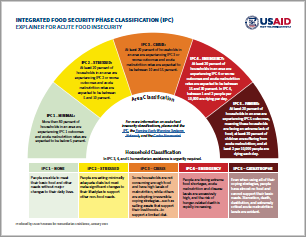Integrated Food Security Phase Classification (IPC) Explainer
AREA Classification
Phase 1 – MINIMAL: More than 80 percent of households in an area are experiencing Phase 1 outcomes , and acute malnutrition rates are expected to be below 5 percent.
Phase 2 – STRESSED: At least 20 percent of households in an area are experiencing Phase 2 or worse outcomes, and acute malnutrition rates are expected to be between 5 and 10 percent.
Phase 3 – CRISIS: At least 20 percent of households in an area are experiencing Phase 3 or worse outcomes, and acute malnutrition rates are expected to be between 10 and 15 percent.
Phase 4 – EMERGENCY: At least 20 percent of households in an area are experiencing Phase 4 or worse outcomes, and acute malnutrition rates are expected to be between 15 and 30 percent.
Phase 5 – FAMINE: At least 20 percent of households in an area are experiencing Phase 5 outcomes, acute malnutrition levels exceed 30 percent, and more than 2 per 10,000 people are dying each day.
HOUSEHOLD Classification
Phase 1 – NONE: People are able to meet their basic food and other needs without major changes to their daily lives.
Phase 2 – STRESSED: People are eating minimally adequate diets but must make significant changes to their lifestyles to support other non-food needs.
In Phases 3, 4 and 5, humanitarian assistance is urgently required.
Phase 3 – CRISIS: Some households are not consuming enough food and have high levels of malnutrition, while others are adopting irreversible coping strategies – such as selling assets that support their livelihoods – to support a limited diet.
Phase 4 – EMERGENCY: People are facing extreme food shortages, acute malnutrition and disease levels are excessively high, and the risk of hunger-related death is rapidly increasing.
Phase 5 – CATASTROPHE: Even when using all of their coping strategies, people have almost no food and cannot support their basic needs. Starvation, death and destitution are apparent.

